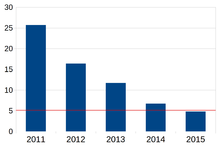| Part of a series on |
| Artificial intelligence |
|---|

The error rate of AI by year. Red line - the error rate of a trained human on a particular task.
Progress in artificial intelligence (AI) refers to the advances, milestones, and breakthroughs that have been achieved in the field of artificial intelligence over time. AI is a multidisciplinary branch of computer science that aims to create machines and systems capable of performing tasks that typically require human intelligence. Artificial intelligence applications have been used in a wide range of fields including medical diagnosis, economic-financial applications, robot control, law, scientific discovery, video games, and toys. However, many AI applications are not perceived as AI: "A lot of cutting edge AI has filtered into general applications, often without being called AI because once something becomes useful enough and common enough it's not labeled AI anymore."[1][2] "Many thousands of AI applications are deeply embedded in the infrastructure of every industry."[3] In the late 1990s and early 21st century, AI technology became widely used as elements of larger systems,[3][4] but the field was rarely credited for these successes at the time.
Kaplan and Haenlein structure artificial intelligence along three evolutionary stages: 1) artificial narrow intelligence – applying AI only to specific tasks; 2) artificial general intelligence – applying AI to several areas and able to autonomously solve problems they were never even designed for; and 3) artificial super intelligence – applying AI to any area capable of scientific creativity, social skills, and general wisdom.[2]
To allow comparison with human performance, artificial intelligence can be evaluated on constrained and well-defined problems. Such tests have been termed subject matter expert Turing tests. Also, smaller problems provide more achievable goals and there are an ever-increasing number of positive results.
Humans still substantially outperform both GPT-4 and models trained on the ConceptARC benchmark that scored 60% on most, and 77% on one category, while humans 91% on all and 97% on one category.[5]
- ^ AI set to exceed human brain power Archived 2008-02-19 at the Wayback Machine CNN.com (July 26, 2006)
- ^ a b Kaplan, Andreas; Haenlein, Michael (2019). "Siri, Siri, in my hand: Who's the fairest in the land? On the interpretations, illustrations, and implications of artificial intelligence". Business Horizons. 62: 15–25. doi:10.1016/j.bushor.2018.08.004. S2CID 158433736.
- ^ a b Kurtzweil 2005, p. 264
- ^ National Research Council (1999), "Developments in Artificial Intelligence", Funding a Revolution: Government Support for Computing Research, National Academy Press, ISBN 978-0-309-06278-7, OCLC 246584055 under "Artificial Intelligence in the 90s"
- ^ Biever, Celeste (25 July 2023). "ChatGPT broke the Turing test — the race is on for new ways to assess AI". Nature. Retrieved 26 July 2023.
